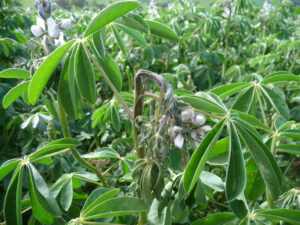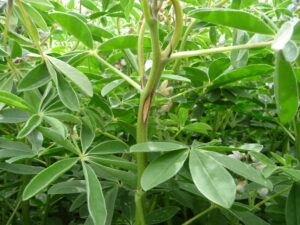Read the latest information on
Foot-and-mouth disease
As winter sowing season approaches, securing clean, healthy seeds is crucial to protect your farm from pests, diseases, and weeds. Infected seeds can introduce hidden threats that spread across states, posing serious risks to Australia’s agriculture industry.
A good example of such a disease is lupin anthracnose (Colletotrichum lupini), a serious condition affecting lupins. It is currently present in South Australia (SA) and Western Australia (WA), but not in New South Wales (NSW) or Victoria (VIC). To prevent it spreading, lupin seed from high-risk areas like SA or WA must meet specific requirements to ensure it is free of the disease before entering NSW or VIC.

Image: Infected lupin plant showing the distinctive bending and twisting of the stem, known as “shepherd’s crook” (Credit: Dr Kurt Lindbeck, NSW DPIRD)

Image: Early stem lesion in lupin caused by anthracnose (Credit: Dr Kurt Lindbeck, NSW DPIRD)
Although the main purpose of seed certification is to maintain the genetic identity and purity of crop varieties, it also plays an important role in ensuring seeds are disease free. Certified seed gives growers peace of mind, ensuring it meets strict quality standards for varietal purity, germination rates, seed content, and minimal disease and weed contamination.
The seed certification quality assurance process monitors the production of high-quality seeds. This is done through field inspections during the growing season and after harvesting, grading by seed processors, and sampling.
Certified seed is produced under internationally recognised rules. It is inspected by official inspectors, graded at authorised seed processors and sampled according to International Seed Testing Association (ISTA) rules by authorised samplers.
The best way to ensure clean seed is to buy from a reputable supplier. Always ask about the seed’s origin and aim to purchase certified or quality assured seed. Certified organic seed is not automatically pest-free, it must also be certified as pest-free.
Unfortunately, you cannot accurately assess seed quality just by looking at it, as seed that appears clean and healthy at the time of purchase may still carry pests or diseases. However, you should always inspect your seed prior to planting for any obvious signs of insects or diseases.
Always keep a copy of the seed certification, as it will assist with trace-back activities if a pest or disease is detected. Record the origin of your seed and track any produce or seeds that leave your property. These records will be valuable if a pest or disease incursion occurs.
The Australian Seed Federation’s website offers a helpful Know before you sow checklist with key questions to ask when buying seed.
Whether you have seed stored for sowing or as feed, it is important to monitor your stored grain for pests and diseases. Four key factors that can impact seed health and disease risk are:
For more information, refer to the Grains Farm Biosecurity Program’s (GFBP) booklet on monitoring stored grain.